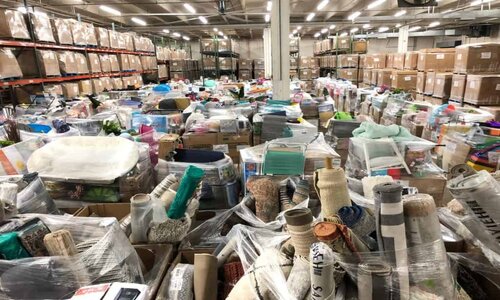Sourcing Liquidation Goods: What You Need to Know
 By
By
Liquidation marketplaces acquire
unwanted inventory from manufacturers and retailers and auction them off at a
fraction of their retail price. These customer returns, overstock, shelf-pulls,
or end-of-life products can no longer be sold on traditional marketplaces, so
they are offloaded to liquidators and wholesale suppliers. Liquidated goods are sold by pallet
or truckload, and they are an excellent source of cheap inventory for resellers
to sell at significant markups to generate profits. The reselling industry is
thriving, with many opportunities for entrepreneurs to succeed within the
business model. If you want to try your hand at
buying liquidation goods to resell, this guide has everything you need to know
about sourcing liquidation goods, including the best practices and tips to get
the most out of your inventory. Where
Do You Find Liquidation Goods? You can source liquidation goods from
various marketplaces. The most common is purchasing overstock inventory
directly from manufacturers and retailers. The items are sold as-is, at a steep
discount, since they need to be cleared out quickly. Overstock merchandise is generally
new and carryover items that retailers can no longer sell at full price. These
items are usually in good condition and can be a boon to resellers as they can
place significant markups on them. Walmart liquidation pallets often contain new merchandise
still sealed in their original packaging, which means they should be easy to
resell. Customer returns may be damaged or
defective, while others may be unwanted. According to the National Retail
Federation, customer returns amounted to $761
billion in 2021
(16.6% of total sales). Order cancellations are another
source of liquidation goods. Sometimes buyers will cancel an order before
shipping, but the supplier has already acquired the item and is preparing it
for delivery. Retailers may choose to liquidate these goods instead of
relisting them on the market. Closeouts are similar to a
clearing-out sale, in which the remaining items in stock are sold at discounted
rates to unload them quickly. Often these items will be phased out, or the
retailer has no plans on acquiring new stock. Liquidation goods can be a great
way to acquire cheap inventory, but it's important to be aware of the potential
risks. The items are sold as-is, which means there are no guarantees about
their condition and quality. The inventory may also be old or outdated, making
them difficult to market and sell. This is why you must do your due
diligence before you purchase liquidated goods and only buy from reputable
sources. How
To Start Your Business With Liquidation Goods Buying liquidation goods is the
best way to start a reselling business. You don’t need much capital, and with
research and careful consideration, you can find high-quality items that can
generate high profits. Here are some simple tips to help
you start your business on the right track: 1.
Get a Resale Certificate To Buy In Bulk A resale certificate exempts
businesses from paying taxes on the merchandise they purchase, as they will
eventually collect taxes when they sell the items to their customers. This is a valuable document for
businesses that purchase inventory in bulk, as it significantly reduces
expenses and increases the scope for profits. If you want to pursue a reselling
business and specialize in buying and selling overstocked items, returns, and
end-of-line merchandise, a resale certificate will do wonders for your future
success. This simple certificate will make
you very competitive in the liquidation marketplace, and it should be one of
your main priorities long before you purchase your first liquidation pallet. 2.
Examine Product Manifests Thoroughly Before you purchase liquidation
goods, you must carefully examine the manifest to ensure that you get items you
know you can sell. The manifest lists all the items included in the shipment,
their condition, quantity, model, serial numbers, functionality, and retail
price. With this information, you can
determine if you can market and sell the items in the pallet or truckload and
generate healthy profits. Carefully reviewing the manifest
will help you avoid surprises and get the best possible deal on your chosen
liquidation goods. 3.
Choose a Niche To Specialize In If you want to dip your toes in the
liquidation world, it’s best to focus on a certain niche. You can learn everything
about the products and better understand your target market. This expertise
will do wonders for your future operations—you will know how much certain items
are truly worth, how much of a markup you can add and still be able to attract
customers, and how best to market your inventory to generate consistent
revenue. You can specialize in consumer
electronics, clothing, pet accessories, office furniture, grocery items, or
luxury goods. Choosing a specific category will make it easier to build your
brand, too. 4.
Consider All Expenses When Pricing Your Goods When pricing liquidation goods to
resell, you must consider all of your expenses. This includes the base cost of
the products, shipping, handling, and storage. You must also factor in other
costs, such as taxes, marketing, logistics, labor, and office admin. Adding everything up will ensure
that you are pricing your goods correctly and not leaving money on the table.
You can maximize your profits and operate a successful reselling business with
the right pricing strategy. 5.
Be Patient Joining your first liquidation auction can be quite
nerve-wracking. The key is to be patient. You will spot pallets with
unbelievably low bids, and you may be tempted to snatch them up as quickly as possible—temper
that instinct and let your strategic mind take the lead. Crunch the numbers and determine your budget for pallets in your
niche. Before you place a bid, think about the types of items you know
you can sell and at what prices. You don’t want to be stuck with unsellable
inventory, no matter how cheap they are. Liquidation
Goods Can Jumpstart Your Business Reselling liquidation goods is a business model with significant
scope for profits. As long as you are mindful of the items you are purchasing,
you can unload inventory as quickly as you acquire them and enjoy long-term
success in the industry. Best of luck!






